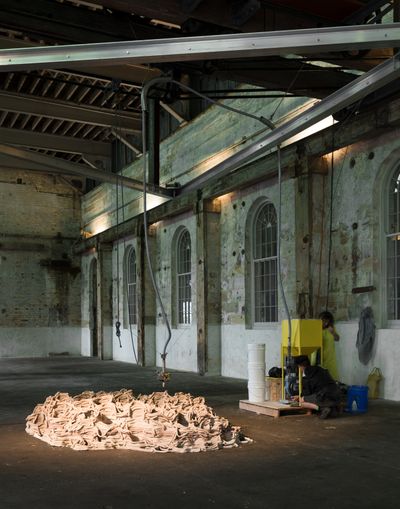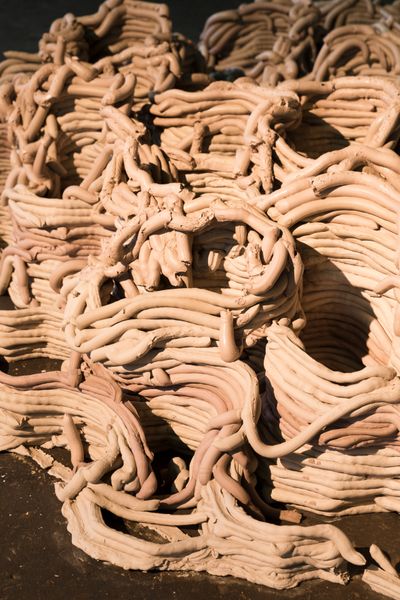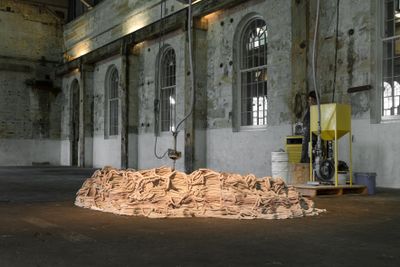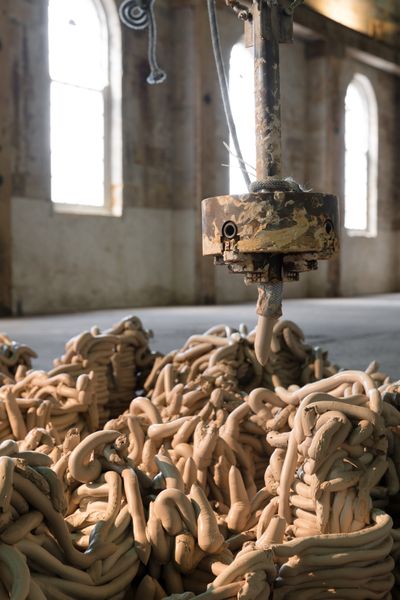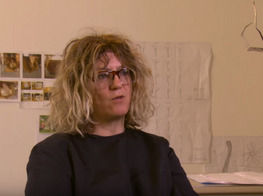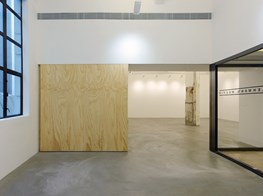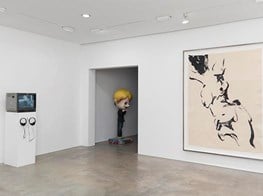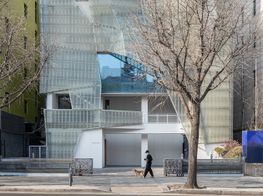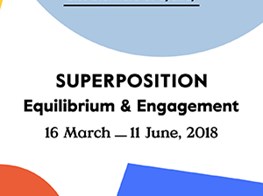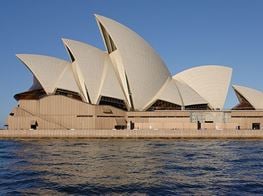Anya Gallaccio
in partnership with the 21st Biennale of Sydney
Anya Gallaccio. Courtesy the artist and Thomas Dane Gallery, London.

Anya Gallaccio. Courtesy the artist and Thomas Dane Gallery, London.
Anya Gallaccio's practice is characterised by the twin notions of control and transition and, in particular, how each can be implemented and represented. Her approach often involves setting in motion a process and then letting go. Her use of materials that innately decay, melt, rot and transform, speak to the mutability of material and place. The work lies in this flux of expectation and reality; of material failing, breaking, collapsing.
Graduating from Goldsmiths in London in the late 1980s, Gallaccio rose to prominence alongside the group of young British artists in the formative 1988 exhibition Freeze, organised by Damien Hirst. For her work Waterloo (1988), she hand-poured one tonne of molten lead directly onto the surface of the floor in an empty London Port Authority building at Surrey Docks in London, where the exhibition took place. Throughout her career, Gallaccio has continued to mine this early idea of the relationship of place and process to explore the political, the romantic and the fantastic.
Gallaccio often develops work through site specificity and material resonance, working with chocolate in Vienna, oranges on the docks of East London, golden coins in Zurich or ice in a London hydroelectric station. Using the everyday, Gallaccio creates elegiac works that examine systems of industry and currency, as well as our relationships to labour, history, nature and, most recently, technology. Her work engages with American Minimalism and Land Art influences as well as the tradition of sculpture. Working in theatre during art school and later with an opera company to support herself during her early career, Gallaccio's practice is also informed by the performative and the theatrical. This is seen in the use of scale and space as well as the encounter of experience and collaboration between the artist, process and audience within her installation work.
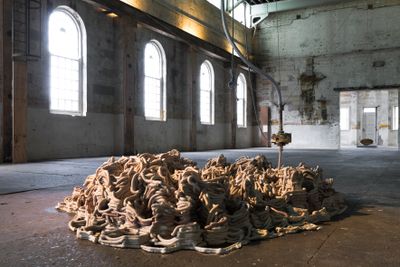
For the 21st Biennale of Sydney (BoS), titled Superposition: Equilibrium and Engagement, Gallaccio's work Beautiful Minds (2015–ongoing) sets technology up for failure, feeding wet clay through a 3D printer in order to build a scale model of a mountain over the exhibition period. This contrary process imbues a codified system of representation with the subjective and the gestural. The structural frailties of the material create a volatile and impermanent form: a poetic distillation of the formative processes of geological time. As with much of Gallaccio's practice, Beautiful Minds excavates ideas of translation, interpretation and loss.
In the weeks leading up to the opening of the 21st Biennale of Sydney we spoke to Gallaccio about Beautiful Minds and the evolution of her practice. Born in Scotland and raised in London, Gallaccio moved to California over ten years ago. She travels regularly between London and the United States. We spoke by phone after one such trip and just prior to her coming to Sydney to install her work.
LGThis year marks 30 years since the exhibition of your work Waterloo at Freeze. How does that catalyst moment 30 years ago feel, looking forward through the rear view to now?
AGIt feels just as precarious now as it did then. And I think it is good to constantly remind myself of that and not to get complacent. The bravado and the chutzpah of Freeze was impressive; it was more about a kind of attitude and that is something that has had reverberations.
LGWhat can you tell us about the new iteration of Beautiful Minds, your work for the 21st Biennale of Sydney?
AGIn 2015 at the Museum of Contemporary Art San Diego, I worked with students there to make a huge 3D digital printer. In Sydney, the printer is building a mountain range. The geologic form of Devil's Tower in Wyoming is being loosely mapped. This a fantastical formation that rises dramatically from flat, open meadow. It is a sacred place and was formally named as the first United States National Monument. The machine is pretty idiosyncratic—the work is an act of faith, and every iteration is different, so I have no guarantee of what will be made.
In the printing process, the clay is extruded and becomes sedimentary—it is a speeding up of geologic formation. The clay is unfired and is unstable; drying out, shifting and moving in the same way that the land is impacted by seismic change. The clay from the first mountain will be reconstituted and reused to build the third, so the process of making and unmaking, of destruction and recycling, is ongoing. Then, at the end of the exhibition, the clay can be recycled or repurposed. I enjoy the idea that this object, which becomes monolithic, will return back to dust.
Beautiful Minds is a work which came out of many inspirations and frustrations, about land use, technology and ideas of progress, but ultimately it is an absurdist work. One of the initial impulses for making this mountain was an obsession with Spielberg's film Close Encounters of the Third Kind. I kept coming back to Richard Dreyfuss' character, who fixates on making a form that he doesn't comprehend but is compelled to find. Throughout the film he doesn't know what he's doing or why but follows an idea. Then he arrives at Devil's Tower and he recognises the form that he has been making. This seems analogous with being an artist and often being compelled beyond reason and good sense to follow instinct against rational logic.
LGHow has the location of the work at the biennale informed its development?
AGCockatoo Island, where the work is located, is a unique site where I can utilise the sense of the rock, of geologic time and production. The clay used is local and pale, almost white in colour. I was interested in the island's history as a site of fabrication and industry. The process of labour is still apparent in the empty buildings. For this project, the space returns to a workshop, a site of production or studio, rather than exhibition hall.
LGDuring your first site visit to Australia in 2017, you travelled with Mami [Kataoka, Artistic Director of the 21st Biennale of Sydney] and a group of artists, including Haegue Yang and Laurent Grasso, to Central Australia. What was that experience like for you and what was the process of your decision to make Beautiful Minds for Sydney?
AGOur visit to Uluru, in particular, was intense. It is a powerful place and an extraordinary landscape. I felt very privileged to be able to visit. I was fixated by the termite mounds and how even the trees were being subsumed by the layers of red and yellow crust, thinking in terms of the geology of Australia, which is so ancient.
I have been asked on a couple of occasions to make something in Sydney, but my uncertainty in how I could engage with the Australian landscape has stopped me. I had initially made this work at the Museum of Contemporary Art San Diego in 2015, with a second iteration at Thomas Dane Gallery in London in 2017. I decided to remake and expand the work in Sydney, as I was curious to see how it would change in the context of Australia and the relationship between the man-made, the built and the natural. I was also excited by the possibility of using the duration of the exhibition and by the nature of the exhibition space.
This work grew out of my move in 2008 to Southern California and an ongoing fascination with the landscape and the open space of the American Southwest. Sydney and California have many things in common: spectacular weather, an outdoors lifestyle, they are both seemingly easy-going. And yet both places have a violent and oppressive history. I live in San Diego, very near the border with Tijuana and, in many ways, it is a strangely isolated existence. I am in the middle of a vast continent and yet somehow everything is telling me I am at the edge or an end point. This is distinct from my experience of growing up in Europe where borders were mostly invisible, more a conceptual barrier—until recently.
LGDo you think the shift towards technology in your practice is a departure point, or an extension of your previous work?
AGI've done three works in the last year using digital technologies. I made this printer. I also made a huge stone tree stump in Texas last year that was CNC [computer numerical controlled] milled, where I scanned a living sequoia tree and then we milled part of it in stone. I also made a sculpture for a school in Belgium, using a digital scan of the inside of an ear. I am interested in technology as a contemporary tool.
For Beautiful Minds, I was interested in the way that digital printing extrudes a single line which works its way methodically through an image file from beginning to end. I started thinking of it as a three-dimensional drawing. It is almost musical how the motors whine as the head of the printer moves around, excreting clay. It is quite comical and ridiculous, and yet mesmerising.
It has been exciting to be able to make something that is both monumental and ephemeral. At the end of the day the mountain gets smashed up which is quite heart-breaking in a way, because I think it's a really beautiful, fantastical object. It is set up to fail, which is something I feel is consistent with all of my work. I set out with an expectation of what it might do, but I cannot ever totally guarantee it. With that, there is a nice loop back to beginning with this work.
LGI always like that recalcitrance of materiality in your work that has something quite specific to do with what Kataoka is talking about in Superposition: Equilibrium and Engagement. Also, I think that element of production and performance in your work is very interesting; that you can create systems that allow for something uncertain.
AGIt has been interesting because people often get very excited. They want to see the machine doing its machine thing. But then they get fixated on how inefficient the machine is or they say, 'but it's going wrong', because it doesn't make this perfect form. For me, that point is what is exciting; having this ideal of something and then the reality of it. In this work, as the clay drips and splodges depending on how it malfunctions, or if it malfunctions, you can start to recognise the forces of gravity and how the material responds—you see process. There is slippage between the code and what the clay does; the clay just doesn't want to behave. There is this loose collaboration between material, place and me. I set something in motion and then see what happens, not interfering.
LGThere's something ineffable about that shared experience with the audience of setting something in motion that you ultimately have no authority over.
AGI have to hand this thing over, and it is really important to me that there is a sense of shared ownership in terms of whoever runs the machine and fills it up with clay every day, and I hope for them it becomes in part their work. Hopefully they will be excited about looking after it and watching it grow, and they enjoy smashing it up at the end.
LGThe expression of ideas around custodial care and accountability in this work is very beautiful. That process, this work is about a handing over of care, despite the eventual dissolution of the object in and of itself.
AGYes, and then it just becomes like a dream. These things live in our memory, or not.—[O]
—


